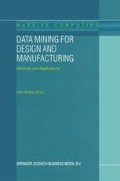Abstract
In the manufacturing of critical components of a product, it is important to ascertain the performance and behaviour of those components being produced before assembly. Frequently, these part components are subject to stringent acceptance tests in order to confirm their conformance to the required specifications. Such acceptance tests are normally monotonous and tedious. At times, they may be costly to carry out and may affect the cycle time of production. This work proposes an approach that is based on genetic algorithms and rough set theory to uncover the characteristics of the part components in relation to their performance using past acceptance test data, that is, the historical data. Such characteristics are described in terms of decision rules. By examining the characteristics exhibited, it may be possible to relax the rigour of acceptance tests. A case study was used to illustrate the proposed approach. It was found that the cost in conducting the acceptance tests and the production cycle time could be reduced remarkably without compromising the overall specifications of the acceptance tests.
Access this chapter
Tax calculation will be finalised at checkout
Purchases are for personal use only
Preview
Unable to display preview. Download preview PDF.
References
Fausett, L.V., Fundamentals of Neural Networks: Architectures, Algorithms, and Applications. Englewood Cliffs, NJ: Prentice-Hall, 1994.
Goldberg, D.E., Genetic Algorithms in Search, Optimisation and Machine Learning. Reading, Mass.: Addison-Wesley Pub. Co., 1989.
Khoo, L.P., Tor, S.B. and Zhai, L.Y., “A Rough-set Based Approach for Classification and Rule Induction,” International Journal of Advanced Manufacturing Technology, 15, 438–444, 1999.
Khoo, L.P. and Zhai, L.Y., “R. Class: A Prototype Rough-set and Genetic Algorithms Enhanced Multi-concept Classification System for Manufacturing Diagnosis,” in Handbook of Computational Intelligence in Design and Manufacturing, Boca Raton: CRC Press LLC, 2000 (in press).
Mitchell, J.S., An Introduction to Machinery Analysis and Monitoring, Tulsa, Oklahoma: PannWell Books Company, 1981.
Pawlak, Z., “Rough Set Approach to Multi-attribute Decision Analysis,” European Journal of Operational Research, 72 (3), 443–459, 1994.
Pawlak, Z., “Rough Set: A New Approach to Vagueness,” in Fuzzy Logic for the Management of Uncertainty, pp. 105–108, New York: John Wiley and Sons, 1992.
Pawlak, Z., “Rough Sets,” in Rough Sets and Data Mining - Analysis for Imprecise Data, pp. 38, Boston, Mass: Kluwer Academic Publishers, 1997.
Pawlak, Z., “Rough Sets,” International Journal of Computer and Information Sciences, 11 (5), 341–356, 1982.
Pawlak, Z, Z., “Why Rough Sets,” in 1996 IEEE International Conference on Fuzzy Systems, pp. 738–743, 1996.
Quinlan, J.R., “Induction of Decision Trees,” Machine Learning, 1, 81–106, 1986.
Quinlan, J.R., C4.5: Programs for Machine Learning, Boston: Morgan Kaufmann Publishers, 1992.
Shafer, G., “Belief Functions and Parametric Models,” Journal of Royal Statistical Socirety, 44, 322–352, 1982.
Shafer, G., A Mathematical Theory of Evidence, Princeton, NN.JY.: Princeton Univ. Press, 1976.
Wong, S.K.M., Ziarko, W. and Li, Y.R., “Comparison of Rough-set and Statistical Methods in Inductive Learning,” International Journal of Man-Machine Studies, 24, 53–72, 1986.
Zadeh, L.A., “Fuzzy Sets,” Information and Control, 8, 338–353, 1965.
Zhai, L.Y., Automated Extraction of Diagnostic Knowledge, Master thesis, Nanyang Technological University, Singapore, 2000.
Author information
Authors and Affiliations
Editor information
Editors and Affiliations
Rights and permissions
Copyright information
© 2001 Springer Science+Business Media Dordrecht
About this chapter
Cite this chapter
Lian-Yin, Z., Li-Pheng, K., Sai-Cheong, F. (2001). Derivation of Decision Rules for the Evaluation of Product Performance Using Genetic Algorithms and Rough Set Theory. In: Braha, D. (eds) Data Mining for Design and Manufacturing. Massive Computing, vol 3. Springer, Boston, MA. https://doi.org/10.1007/978-1-4757-4911-3_14
Download citation
DOI: https://doi.org/10.1007/978-1-4757-4911-3_14
Publisher Name: Springer, Boston, MA
Print ISBN: 978-1-4419-5205-9
Online ISBN: 978-1-4757-4911-3
eBook Packages: Springer Book Archive

